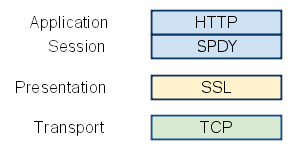SPDY Results on Google Sites
 Exactly four years ago, Google announced the SPDY protocol, which was conceived as an upgrade for HTTP 1.1 in order to significantly increase the speed of all types of connections. SPDY halves latency when working via HTTP. This is done through three methods: 1) multiplexing requests; 2) prioritization of requests; 3) HTTP header compression.
Exactly four years ago, Google announced the SPDY protocol, which was conceived as an upgrade for HTTP 1.1 in order to significantly increase the speed of all types of connections. SPDY halves latency when working via HTTP. This is done through three methods: 1) multiplexing requests; 2) prioritization of requests; 3) HTTP header compression.The first "laboratory" tests SPDY showed an increase in the speed of loading web pages by 55% , in mobile networks - by 23% . However, independent tests on real sites showed no increase in performance at all. One of the reasons is that real sites have resources that are loaded from different domains, including those with no SPDY support.
Over the past four years, much has changed. SPDY itself is optimized and grown to version 3.1, and it was decided to make it the basis for the next generation protocol HTTP 2.0 . The current implementation is supported in all modern browsers, including Chrome, Opera, Firefox and even Internet Explorer, dozens of server platforms and many large sites.
Yesterday, Google published the SPDY test results on its own sites. These are not laboratory tests, but real statistics from millions of user sessions with different types of Internet connections, that is, with different access speeds.
')
The table shows the change in the latency rate — the time between sending a request and receiving the first incoming event in the browser. The median value is indicated, the average is for 5% of the fastest compounds and for 95% of the rest.
| Google News | Google sites | Google drive | Google maps | |
| Median average | -43% | -27% | -23% | -24% |
| 5% fastest | -32% | -thirty% | -15% | -20% |
| 95% of the rest | -44% | -33% | -36% | -28% |
The tests used Chrome 29 and compared the work on HTTPS and SPDY.
Naturally, on other sites using SPDY may not give such an effect. The specific result depends on the amount of downloaded content from foreign resources and on dozens of other factors.
At the same time, Google says it continues to optimize the compression, flow control, and traffic prioritization algorithms in SPDY. There are a lot of interesting ideas, so by the time the HTTP / 2 standard is adopted, this protocol will work even more efficiently.
Source: https://habr.com/ru/post/202998/
All Articles